check engine RENAULT WIND 2012 1.G User Guide
[x] Cancel search | Manufacturer: RENAULT, Model Year: 2012, Model line: WIND, Model: RENAULT WIND 2012 1.GPages: 185, PDF Size: 5.52 MB
Page 114 of 185
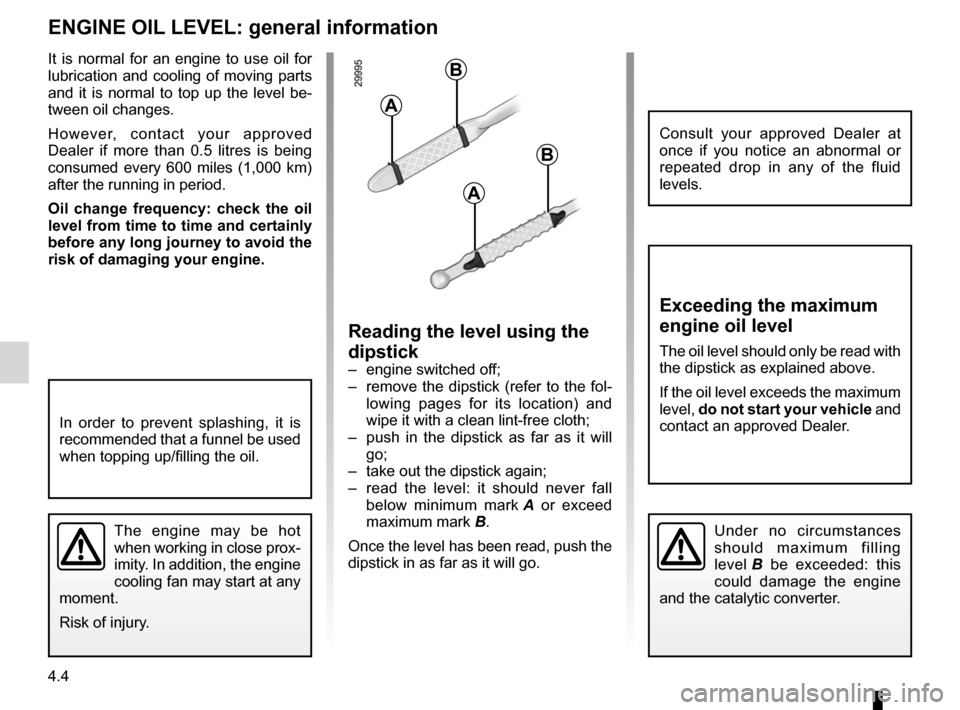
engine oil .............................................. (up to the end of the DU)
oil change ............................................. (up to the end of the DU)
engine oil level ...................................... (up to the end of the DU)
4.4
ENG_UD11215_1
Niveau huile moteur : généralités (E33 - X33 - Renault)
ENG_NU_865-6_E33_Renault_4
Engine oil level:
general information
engine oil level: general information
It is normal for an engine to use oil for
lubrication and cooling of moving parts
and it is normal to top up the level be-
tween oil changes.
However, contact your approved
Dealer if more than 0.5 litres is being
consumed every 600 miles (1,000 km)
after the running in period.
oil change frequency: check the oil
level from time to time and certainly
before any long journey to avoid the
risk of damaging your engine.
Reading the level using the
dipstick
– engine switched off;
– remove the dipstick (refer to the fol-
lowing pages for its location) and
wipe it with a clean lint-free cloth;
– push in the dipstick as far as it will
go;
– take out the dipstick again;
– read the level: it should never fall
below minimum mark A or exceed
maximum mark B.
Once the level has been read, push the
dipstick in as far as it will go.
A
A
B
B
exceeding the maximum
engine oil level
The oil level should only be read with
the dipstick as explained above.
If the oil level exceeds the maximum
level, do not start your vehicle and
contact an approved Dealer.
Under no circumstances
should maximum filling
level B be exceeded: this
could damage the engine
and the catalytic converter.The engine may be hot
when working in close prox-
imity. In addition, the engine
cooling fan may start at any
moment.
Risk of injury.
Consult your approved Dealer at
once if you notice an abnormal or
repeated drop in any of the fluid
levels.
In order to prevent splashing, it is
recommended that a funnel be used
when topping up/filling the oil.
Page 115 of 185

engine oil .............................................. (up to the end of the DU)
oil change ............................................. (up to the end of the DU)
engine oil level ...................................... (up to the end of the DU)
engine oil capacity ................................ (up to the end of the DU)
4.5
ENG_UD20478_2
Niveau huile moteur : appoint/remplissage (E33 - X33 - Renault)
ENG_NU_865-6_E33_Renault_4
– Unscrew cap 1;
– top up the level (as a guide, the ca-
pacity between the minimum and
maximum reading on dipstick 2 is
between 1.5 and 2 litres, depending
on the engine);
– wait for approximately 10 minutes to
allow the oil to flow into the engine;
– check the level using dipstick 2 (as
described above).
Once the level has been read, push the
dipstick in as far as it will go.t opping up/filling
The vehicle must be parked on level
ground and the engine should be cold
(for instance, before the engine is
started up for the first time in the day).
engine oil grade
Refer to the Maintenance Service
Booklet for your vehicle.
topping up/filling
engine oil level : topping up/filling (1/2)
Do not exceed the max level and
do not forget to refit cap 1 and dip-
stick 2.
12
1
2
Page 117 of 185

levels:coolant ............................................................. (current page)
tanks and reservoirs coolant ............................................................. (current page)
coolant ................................................................... (current page)
4.7
ENG_UD20479_2
Niveaux / filtres (E33 - X33 - Renault)
ENG_NU_865-6_E33_Renault_4
Levels:
engine coolant
levelS (1/3)
Coolant
With the engine switched off and on
level ground, the level when cold must
be between the “MINI” and “MAXI”
marks on coolant reservoir 1.
Top this level up when cold before it
reaches the MIN mark. Checking intervals
Check the coolant level regularly
(very severe damage is likely to be
caused to the engine if it runs out of
coolant).
If the level needs to be topped up, only
use products approved by our Technical
Department which ensure:
–
protection against freezing;
– anticorrosion protection of the cool -
ing system.
Replacement intervals
Refer to the Maintenance Document for
your vehicle.
No operations should be
carried out on the cooling
circuit when the engine is
hot.
Risk of burns.
The engine may be hot
when working in close prox-
imity. In addition, the engine
cooling fan may start at any
moment.
Risk of injury.
When working in the engine
compartment, ensure that
the windscreen wiper stalk
is in the park position.
Risk of injury.
1
Consult your approved dealer at
once if you notice an abnormal or
repeated drop in any of the fluid
levels.
Page 118 of 185

brake fluid .............................................................. (current page)
levels: brake fluid ........................................................ (current page)
tanks and reservoirs brake fluid ........................................................ (current page)
4.8
ENG_UD20479_2
Niveaux / filtres (E33 - X33 - Renault)
ENG_NU_865-6_E33_Renault_4
Jaune NoirNoir texte
brake fluid
levelS (2/3)
Brake fluid level
This should be checked frequently,
and immediately if you notice even the
slightest loss in braking efficiency.
The level should be read with the engine
switched off and on level ground. level 2
It is normal for the level to drop as the
brake shoes become worn, but it must
never drop lower than the
“Min” warn-
ing line.
If you wish to check the disc and drum
wear yourself, you should obtain the
document explaining the checking pro-
cedure from our network or from the
manufacturer’s website. t
opping up
After any operation on the hydraulic cir-
cuit, a specialist must replace the fluid.
Only use fluids approved by our
Technical Department (and taken from
a sealed container).
Replacement intervals
Refer to the Maintenance Document for
your vehicle.
The engine may be hot
when working in close prox-
imity. In addition, the engine
cooling fan may start at any
moment.
Risk of injury.When working in the engine
compartment, ensure that
the windscreen wiper stalk
is in the park position.
Risk of injury.
2
Page 121 of 185

battery................................................... (up to the end of the DU)
4.11
ENG_UD11219_1
Batterie (E33 - X33 - Renault)
ENG_NU_865-6_E33_Renault_4
Battery
Battery 1 does not require any mainte-
nance.
Battery
Handle the battery with care
as it contains sulphuric acid,
which must not come into
contact with eyes or skin. If
it does, wash the affected area with
plenty of cold water. If necessary,
consult a doctor.
Ensure that naked flames, red hot
objects and sparks do not come into
contact with the battery as there is a
risk of explosion.
BA tteR y
Depending on the vehicle, a system
continuously checks the battery charge
status. If the level drops, the message
“CHARGE BATTERY ” is displayed on
the instrument panel. In this case, start
the engine. The charge status of your
battery can decrease especially if you
use your vehicle:
– for short journeys;
– for driving in town;
– when the temperature drops;
– after extended use of consumers
(radio etc.) with the engine switched
off.
Replacing the battery
As this operation is complex, we advise
you to contact an approved Dealer.
The engine may be hot
during operations in close
proximity. In addition, the
engine cooling fan may
start at any moment.
Risk of injury.
A234
567
The battery is a specific
type , please ensure it is
replaced with the same
type. Consult an approved
dealer.
1
label A
Observe the indications on the battery:
– 2 naked flames and smoking forbid-
den;
– 3 eye protection required;
– 4 keep away from children;
– 5 explosive materials;
– 6 refer to the handbook;
– 7 corrosive materials.
Page 123 of 185
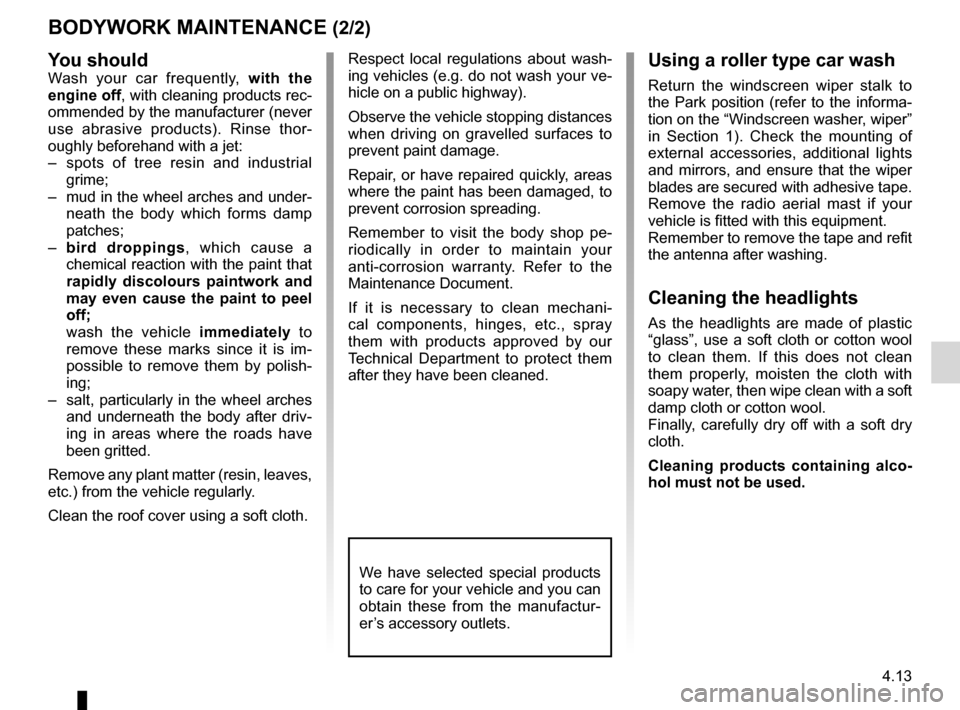
JauneNoirNoir texte
4.13
ENG_UD30003_4
Entretien de la carrosserie (E33 - X33 - Renault)
ENG_NU_865-6_E33_Renault_4
BoDyWoRk MAintenAnCe (2/2)
y ou should
Wash your car frequently, with the
engine off, with cleaning products rec-
ommended by the manufacturer (never
use abrasive products). Rinse thor -
oughly beforehand with a jet:
– spots of tree resin and industrial
grime;
– mud in the wheel arches and under -
neath the body which forms damp
patches;
– bird droppings , which cause a
chemical reaction with the paint that
rapidly discolours paintwork and
may even cause the paint to peel
off;
wash the vehicle immediately to
remove these marks since it is im -
possible to remove them by polish -
ing;
– salt, particularly in the wheel arches
and underneath the body after driv -
ing in areas where the roads have
been gritted.
Remove any plant matter (resin, leaves,
etc.) from the vehicle regularly.
Clean the roof cover using a soft cloth. Respect local regulations about wash
-
ing vehicles (e.g. do not wash your ve-
hicle on a public highway).
Observe the vehicle stopping distances
when driving on gravelled surfaces to
prevent paint damage.
Repair, or have repaired quickly, areas
where the paint has been damaged, to
prevent corrosion spreading.
Remember to visit the body shop pe -
riodically in order to maintain your
anti-corrosion warranty. Refer to the
Maintenance Document.
If it is necessary to clean mechani -
cal components, hinges, etc., spray
them with products approved by our
Technical Department to protect them
after they have been cleaned.
We have selected special products
to care for your vehicle and you can
obtain these from the manufactur -
er’s accessory outlets.
Using a roller type car wash
Return the windscreen wiper stalk to
the Park position (refer to the informa-
tion on the “Windscreen washer, wiper”
in Section 1). Check the mounting of
external accessories, additional lights
and mirrors, and ensure that the wiper
blades are secured with adhesive tape.
Remove the radio aerial mast if your
vehicle is fitted with this equipment.
Remember to remove the tape and refit
the antenna after washing.
Cleaning the headlights
As the headlights are made of plastic
“glass”, use a soft cloth or cotton wool
to clean them. If this does not clean
them properly, moisten the cloth with
soapy water, then wipe clean with a soft
damp cloth or cotton wool.
Finally, carefully dry off with a soft dry
cloth.
Cleaning products containing alco -
hol must not be used.
Page 149 of 185
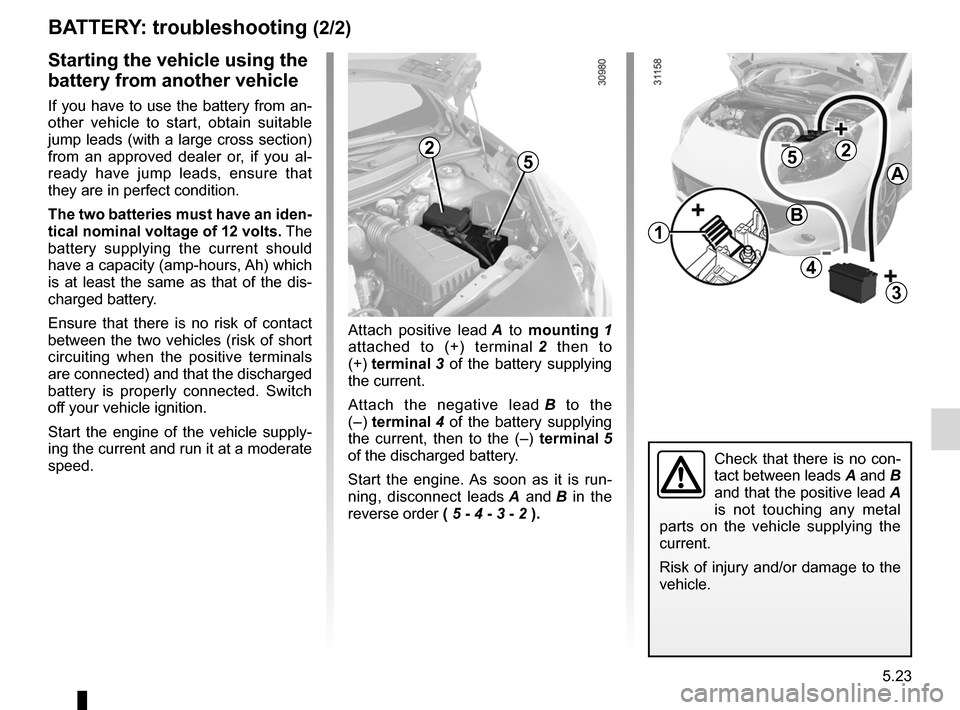
JauneNoirNoir texte
5.23
ENG_UD11233_1
Batterie : dépannage (E33 - X33 - Renault)
ENG_NU_865-6_E33_Renault_5
Attach positive lead A to mounting 1
attached to (+) terminal 2 then to
(+) terminal 3 of the battery supplying
the current.
Attach the negative lead B to the
(– ) terminal 4 of the battery supplying
the current, then to the (–) terminal 5
of the discharged battery.
Start the engine. As soon as it is run -
ning, disconnect leads A and B in the
reverse order ( 5 - 4 - 3 - 2 ).
starting the vehicle using the
battery from another vehicle
If you have to use the battery from an-
other vehicle to start, obtain suitable
jump leads (with a large cross section)
from an approved dealer or, if you al -
ready have jump leads, ensure that
they are in perfect condition.
the two batteries must have an iden-
tical nominal voltage of 12 volts. The
battery supplying the current should
have a capacity (amp-hours, Ah) which
is at least the same as that of the dis-
charged battery.
Ensure that there is no risk of contact
between the two vehicles (risk of short
circuiting when the positive terminals
are connected) and that the discharged
battery is properly connected. Switch
off your vehicle ignition.
Start the engine of the vehicle supply -
ing the current and run it at a moderate
speed.
Battery: troubleshooting (2/2)
Check that there is no con-
tact between leads A and B
and that the positive lead A
is not touching any metal
parts on the vehicle supplying the
current.
Risk of injury and/or damage to the
vehicle.
25
1
25
3
4
a
B
Page 154 of 185

operating faults ..................................... (up to the end of the DU)
practical advice ..................................... (up to the end of the DU)
faults operating faults ............................... (up to the end of the DU)
5.28
ENG_UD20505_2
Anomalie de fonctionnement (E33 - X33 - Renault)
ENG_NU_865-6_E33_Renault_5
Jaune NoirNoir texte
Operating faults
OPeratIng F auLts (1/7)
the following advice will enable you to carry out quick, temporary repairs. For safety reasons you should always contact
an approved dealer as soon as possible.
the starter is activated POssIBLe causesWHat tO dO
There is no response, the warning lights
fail to light up and the starter does not
turn. Battery lead disconnected or terminals
corroded.
Check battery terminals: scrape and
clean if oxidised and retighten.
Discharged battery. Connect another battery to the faulty
battery.
Battery unserviceable. Replace battery.
Warning lights go dim and starter turns
very slowly. Battery terminals not correctly tightened,
oxidised.Check battery terminals: scrape and
clean if oxidised and retighten.
Discharged battery. Connect another battery to the faulty
battery.
It is difficult to start the engine in wet
weather or after washing the vehicle. Poor ignition, ignition system damp.
Dry the spark plug and coil wires.
The engine is difficult to start when hot. Faulty carburation (bubbles of vaporised
fuel in the circuit).Let the engine cool down.
Poor compression. Consult an approved dealer.
Page 155 of 185
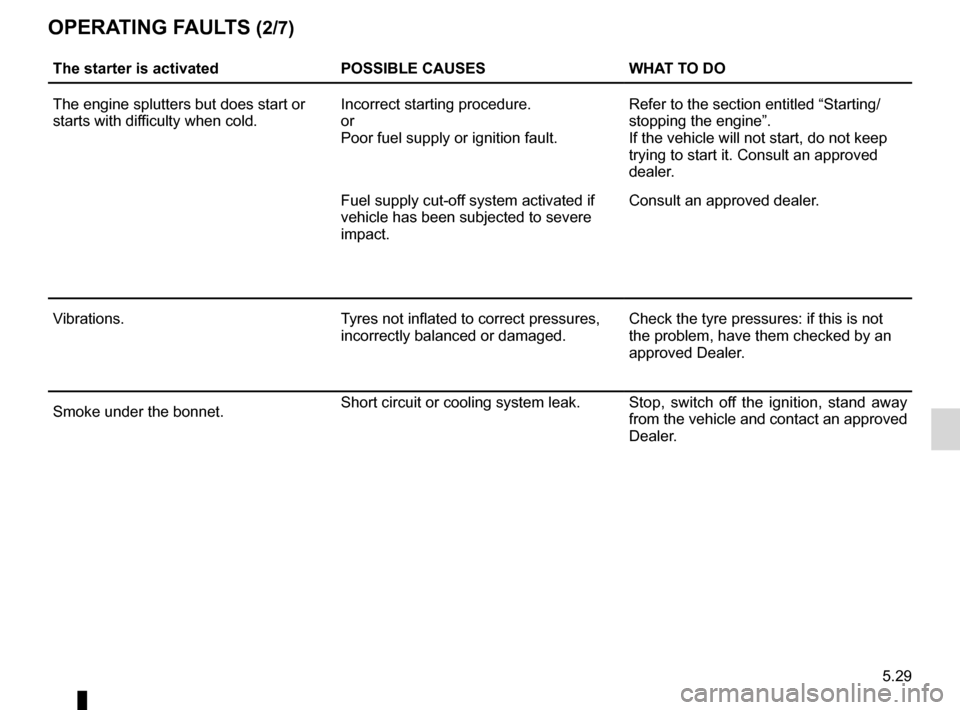
JauneNoirNoir texte
5.29
ENG_UD20505_2
Anomalie de fonctionnement (E33 - X33 - Renault)
ENG_NU_865-6_E33_Renault_5
the starter is activated POssIBLe causesWHat tO dO
The engine splutters but does start or
starts with difficulty when cold. Incorrect starting procedure.
or
Poor fuel supply or ignition fault.Refer to the section entitled “Starting/
stopping the engine”.
If the vehicle will not start, do not keep
trying to start it. Consult an approved
dealer.
Fuel supply cut-off system activated if
vehicle has been subjected to severe
impact. Consult an approved dealer.
Vibrations. Tyres not inflated to correct pressures,
incorrectly balanced or damaged.Check the tyre pressures: if this is not
the problem, have them checked by an
approved Dealer.
Smoke under the bonnet. Short circuit or cooling system leak.
Stop, switch off the ignition, stand away
from the vehicle and contact an approved
Dealer.
OPeratIng FauLts (2/7)
Page 156 of 185
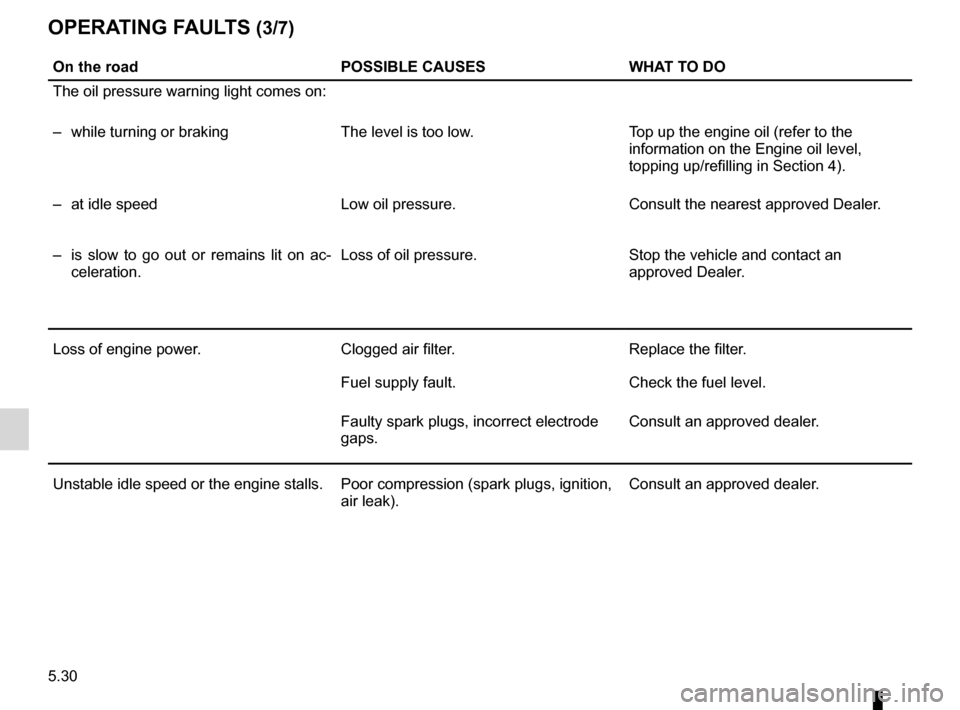
5.30
ENG_UD20505_2
Anomalie de fonctionnement (E33 - X33 - Renault)
ENG_NU_865-6_E33_Renault_5
Jaune NoirNoir texte
On the road POssIBLe causesWHat tO dO
The oil pressure warning light comes on:
– while turning or braking The level is too low. Top up the engine oil (refer to the
information on the Engine oil level,
topping up/refilling in Section 4).
– at idle speed Low oil pressure. Consult the nearest approved Dealer.
– is slow to go out or remains lit on ac-
celeration. Loss of oil pressure.
Stop the vehicle and contact an
approved Dealer.
Loss of engine power. Clogged air filter.Replace the filter.
Fuel supply fault. Check the fuel level.
Faulty spark plugs, incorrect electrode
gaps. Consult an approved dealer.
Unstable idle speed or the engine stalls. Poor compression (spark plugs, ignition,
air leak).Consult an approved dealer.
OPeratIng F
auLts (3/7)